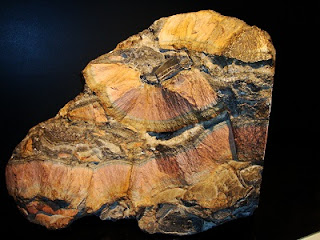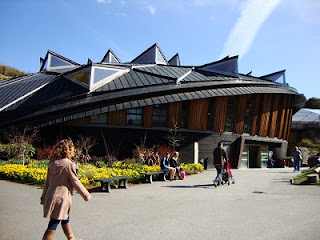The Eden Project is constructed in a 160-year-old exhausted china clay- Kaolinite (Kaolinite is a clay mineral with the chemical composition
Al2 Si2 O5(OH)4) quarry at Bodelva, near St. Austell, in Cornwall, UK. It was established as one of the Landmark Millennium Projects to mark the year 2000 in the UK.
The complex is dominated by two gigantic enclosures consisting of adjoining domes (biomes) that house plant species from around the world. Each enclosure emulates a natural biome. The domes consist of hundreds of hexagonal and pentagonal, inflated, plastic cells supported by steel frames. The first dome emulates a tropical environment, and the second a Mediterranean environment. The Tropical Biome, covers 1.56 hectares (3.9 acres) and measures 55 metres (180 ft) high, 100 metres (328 ft) wide and 200 metres (656 ft) long. It is used for tropical plants, such as fruiting banana trees, coffee, rubber and giant bamboo, and is kept at a tropical temperature and moisture level. 
Inside the artificial biomes are plants that are collected from all around the world. With help from Reading University over 83,000 tonnes of soil was prepared. The mineral component came from local mine wastes: sand from IMERYS china clay works and clay from WBB Devon Clays Ltd. In the Biomes, composted bark provided the organic matter component because it needed to be long lived.
The rapid growers in the Rainforest Biome needed a rich organic soil capable of holding lots of water and nutrients while the slower growers in the drier Mediterranean Biome used a sandy mix which held less of both. A specialist nutrient-free mix was used in the South African Fynbos, where fertile soil is toxic to some of the plants.
For outdoors, composted domestic green wastes was used. The ingredients were mixed with a JCB in a nearby clay pit, and Wiggly Wigglers worms helped dig and fertilise the new earth. This showed the regeneration of soil is possible.
In the first two months of construction since it rained every day; 43 million gallons of rainwater drained into the pit. This prompted the engineers to come up with a magnificent subterranean drainage system that now collects all the water coming on to the site. it used to irrigate the plants and flush loos, while rainwater that falls on the Biomes is used to maintain the humidity inside the Rainforest Biome. The only main pipe (tap) water used is for hand washing and for cooking. Water needs are met from water harvested on site.
The complex also uses Green Tariff Electricity — the energy comes from one of the many wind turbines in Cornwall, which were among the first in Europe.
The covered Biome climates are constantly monitored and are controlled automatically. In the Rainforest Biome automated misters moisten the air (90% relative humidity at night, and down to 60% in the day) and ground-level pipes irrigate the soil so you don’t have to put up with the rainforest’s 1,500 mm (60 inches) of rain a year. The huge waterfall uses recycled water and keeps humidity high. In the Mediterranean it is keept drier. Vents are often open, even during cool periods, to reduce humidity and therefore fungal problems. The main heating source for both Biomes is the sun. The back wall acts as a heat bank, releasing warmth at night. The two layers of air in the triple-glazed windows provide insulation. Extra heating comes from the big grey air-handling units which also help circulate the air on hot days.
Around 1 million plants of just under 4,000 taxa (species and cultivars) have been planted. Most are not rare, except for the few that need for conservation, neither were they taken from the wild. Many were grown from seed in the nursery, others are from botanic gardens, research stations and supporters, mostly in Europe and the UK.
The Core is the latest addition to the site and opened in September 2005. It provides the Eden Project with an education facility, incorporating classrooms and exhibition spaces designed to help communicate Eden's central message about the relationship between people and plants. Accordingly, the building has taken its inspiration from plants, most noticeable in the form of the soaring timber roof, which gives the building its distinctive shape.
Sculptures include a giant bee, cow, driftwood sculpture of a horse by Heather Jansch, at the main entrance of Eden and towering robot called RSA WEEE Man created from oldelectrical appliances.
The Land trains are used to reach the Biome site.
The domes provide diverse growing conditions. The computer-controlled environmental control system that regulates the temperature and humidity in each dome was designed and installed by HortiMaX Ltd. who are also responsible for ongoing maintenance of the environmental control and monitoring systems on both the Biomes and Glasshouses at their production site.




















































































